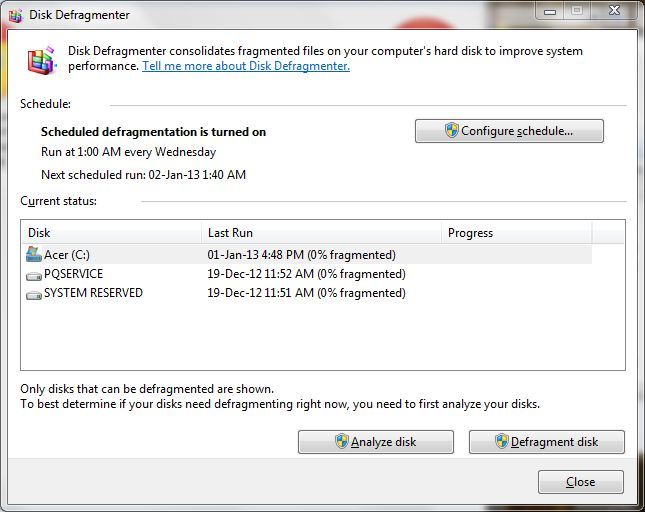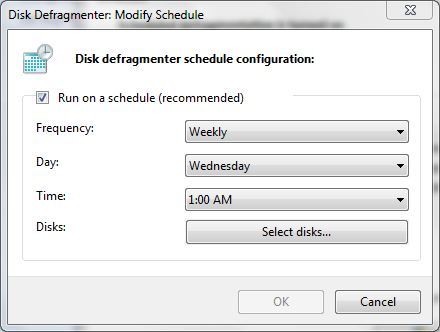Why should I do it?
As we explained last week, the easiest way to think about this is to imagine your disk as a filing cabinet with lots of tiny drawers. If there isn’t enough space in one drawer for a document, individual pages may be stored in different drawers. Then, when you need that document, you have to go through all the drawers, find all the pages, and assemble the document in the right order before you can use it. That’s a slow process. The fuller your disk, the more likely it is that your documents are going to be fragmented.
Defragmenting (or defragging) your disk organizes all those scattered pages back into the right order. This saves you disk space and makes it faster to retrieve and save documents.
When should I defrag?
Defragging once a month should be more than sufficient. Under normal usage, you can probably leave it two or three months with no ill effects. If you install and uninstall a lot of programs, or work with large files such as videos or high-res pictures, you’re more likely to need to defrag your disk. If most of your work is on the Web, or involves short documents, fragmentation isn’t likely to be a major problem for you.
If you’re using Vista or Windows 7, you’ve probably got a defrag scheduled to run weekly without you realizing it. The only problem is that by default it’s set to run at 1am on Wednesdays, and if your computer is turned off at that time, it’s not doing its job.
Adjusting the defrag schedule
Find the Windows defrag tool by clicking on the Start menu and typing defrag into the search box. Then click on Disk Defragmenter.
Adjust the schedule by clicking on Configure Schedule, then choose a time when your computer will be on. Don’t pick a time when you’re going to be working, as it will probably take a while and will slow your computer down. You could set it to run over lunchtime, or some evening when you can safely leave your computer switched on.
Manual defrag
If you want to run it manually, then start by clicking the Analyze Disk button and find out whether it’s worth defragging. Before you defrag a disk, the defragger will normally analyze it. You probably don’t need to defrag the disk if it’s less than 10% fragmented. If the scheduled defragger is working, then you may not need to do anything – ever!
Then click Defragment Disk and let it run. If you’ve got a large disk, or there’s a lot of fragmentation, this could take a few hours. It’s sometimes best to leave it overnight.
Other tools
There are many other free tools that you can use to defrag your PC. The Windows tools will probably do fine for normal use, but some IT experts suggest that other tools do the job better or faster. They may also have additional features that you find useful.
Two that we recommend are
- Piriform Defraggler (particularly useful if you have XP and want to schedule a regular defrag)
- Auslogics Disk Defrag Free
TIP: Don’t install a defragger without checking on Google for positive reviews from reputable sources. Some defraggers can really mess your computer up, and some contain malware. If in doubt, stick with the inbuilt Windows defrag tools.








1 Comment